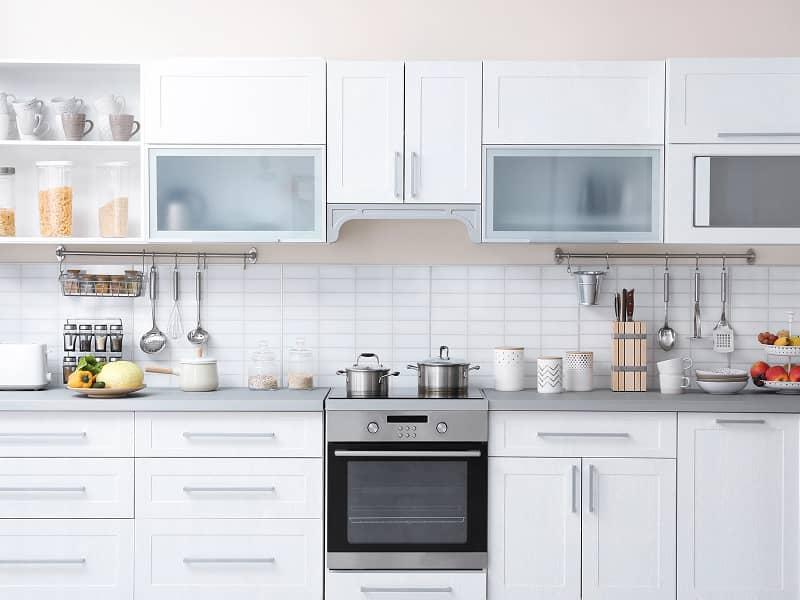TL DR:
Choose the right layout—L-shaped, U-shaped, galley, G-shaped, or open concept—based on your kitchen’s size and family needs. Plan your work triangle, storage, lighting, and traffic flow carefully. Remodeling? Weigh pros and cons before altering walls. Heiston Group can inspect structural issues, propose fixes, and guide you from design to installation.
Your kitchen isn’t just where meals happen—it’s where life happens. Choosing the right layout means thinking beyond aesthetics. It’s about function, flow, and making daily routines smoother and faster.
In Arlington homes, space varies wildly. Some kitchens are tight; others open into dining or living areas. Picking the best layout depends on how you cook, gather, and live. Let’s dig into the options.

Layout That Suits Your Home
Choosing a kitchen layout isn’t about copying what’s trendy—it’s about what fits your space and how your family functions. Each design has strengths, limitations, and ideal use cases.
|
Layout |
Best For |
Pros |
Cons |
|
L‑shaped |
Medium to large, open spaces. |
Flexible, supports work triangle, easy socializing. |
Can leave unused corner cabinets. |
|
U‑shaped |
Larger kitchens, multi‑cooking use. |
Tons of counter/storage space, efficient workflow. |
It can feel cramped if the walkway is too narrow. |
|
Galley |
Small lots or narrow rooms. |
Efficient, low‑cost, no wasted space. |
Can feel closed off, limited social interaction. |
|
G‑shaped |
Large kitchens, added workspace |
Extra counters/bar area, great for prepping and dining. |
Needs lots of room, can feel crowded. |
|
Open concept |
Family spaces, entertaining |
Social, bright, spacious, and visible from other rooms. |
Noise travels, needs extra storage, and may lack wall space. |
L‑Shaped
An L-shaped design places two countertop runs at right angles. It works well in Arlington homes where the kitchen shares space with a breakfast nook or living area.
This layout supports a natural “work triangle” between the stove, fridge, and sink, while still allowing for clear sightlines. Just pay attention to corner storage—lazy Susans and pull-out drawers help.
U‑Shaped
A U-shaped layout surrounds you on three sides—ideal for multiple cooks and heavy prep. If your family loves to cook together or you host big gatherings, this is a solid pick. Just ensure your aisles are at least 42 inches wide to avoid feeling boxed in.
Galley
Galley kitchens use parallel counters, perfect for narrow or smaller Arlington homes. This layout maximizes efficiency and can be very budget-friendly.
However, unless you knock down a wall or two, it can feel tight. Keep traffic minimal and streamline storage to avoid clutter.
G‑Shaped
A G‑shape adds a partial fourth wall, often incorporating a peninsula or breakfast bar. Excellent for large families and entertaining.
You get extra counter space and a casual dining spot. But make sure the overall footprint is big enough to prevent congestion.
Open Concept
This layout blends the kitchen with the living and dining spaces. It’s modern and sociable, perfect for families who like to cook while interacting.
However, open areas can lack storage and hideaway space, so build in islands, pantries, or floor-to-ceiling cabinets to keep things tidy. A well-planned kitchen layout can make cooking easier, cleanup quicker, and gatherings more enjoyable.
Workflow & The Work Triangle
A great kitchen layout means nothing if your workflow is clunky. The work triangle connects your sink, stove, and fridge—streamlining movement and reducing wasted steps during daily prep.
Maximize efficiency with the “work triangle”—a design principle connecting stove, sink, and refrigerator. Aim for:
- Total Triangle Distance: 12–26 feet for optimal flow.
- Each Leg: Between 4 and 9 feet apart.
- Uninterrupted Paths: No islands or tall cabinets in between.
Apply this to any layout:
- L & U — shape the counter runs around it.
- Galley — triangle forms along the length of the kitchen.
- G & open — make sure the island/island edges don’t block traffic.
If the triangle feels off, so will everything else. Stick to the distance rules, keep it clear, and adjust the layout to suit your rhythm in the kitchen.
Smart Storage & Space Tricks
A beautiful kitchen isn’t useful if it’s cluttered. Smart storage transforms chaos into calm, making the most of every drawer, cabinet, and awkward corner for true efficiency.
- Deep drawers are more accessible than base cabinets.
- Vertical dividers help organize baking sheets and trays.
- Pull-out pantry shelves make use of tall gaps.
- Corner pull-outs prevent hard-to-reach zones.
- Hanging rails for pots, utensils, and mugs save counter space.
- Island storage packs in extra drawers or cabinets
Little tweaks can make a big difference. Well-placed drawers, vertical storage, and pull-outs keep tools close and surfaces clear, turning frustration into a fluid cooking experience every day.
Light, Ventilation & Power
Lighting affects mood, visibility, and function. Pair that with proper ventilation and enough outlets, and you’ve got a kitchen that supports you from morning to night, without shadows or smoke.
- Combine overhead lighting with task-focused fixtures under cabinets.
- Position your range under a vent hood that exhausts effectively, especially important in open layouts.
- Add skylights or windows to bring in natural light and airflow.
- Plan electrical outlets on multiple walls, along islands, and near prep zones.
Don’t treat lighting and airflow as afterthoughts. Layer your lighting, vent your space, and scatter outlets wisely to avoid bottlenecks and brighten every moment spent in the kitchen.
Breaking Walls Vs. Keeping Structure
Altering your floor plan can open possibilities—or a can of worms. Knowing which walls to move and which to keep is key to safe, smart remodeling in Arlington homes.
Thinking of knocking down walls? Here’s what to weigh:
Pros:
- Creates an open flow into the living/dining.
- Brings more light into the kitchen.
- Expands kitchen size without building out.
Cons:
- Can affect structural stability—requires consultation and permits.
- Possible rework of plumbing/electrical, and HVAC.
- Increases cost significantly, plus waste and disruption.
Knocking down walls might sound liberating, but the consequences can get expensive fast. Always consult pros before swinging the sledgehammer. Structure first, style second—it’s the only way to build right.
Family Needs: Matching Layouts To Lifestyle
No two households use a kitchen in the same way. A layout should reflect your routines, from weekday breakfasts to weekend baking binges, and everything in between.
- Empty nesters may gravitate toward L-shaped or U-shaped layouts—open yet intimate.
- Families with young kids often prefer islands or peninsulas that double as snack/breakfast zones, with storage close at hand.
- Multiple cooks or avid entertainers benefit from G-shaped designs or open layouts where several people can work together.
- Small-space households do well with galley kitchens to maximize footprint; keep it light and bright to avoid feeling cramped.
A kitchen should adapt to your family, not the other way around. Whether solo chef or full-on food squad, pick a layout that fits your lifestyle, not just your square footage.
Heiston Group: Your Arlington Kitchen Ally
We know Arlington homes inside and out. From old craftsman layouts to modern builds, we help homeowners create kitchens that are functional, stylish, and built to stand the test of time.
Why We’re Your Best Bet
We understand Arlington homes—from 1950s ranchers to modern infills. We’ve helped dozens of homeowners reimagine their kitchens.
Your layout is more than counters—it’s a workflow, a social hub, a design statement. We take a hands-on approach:
- Inspection & Detection: We identify structural walls vs partitions and hidden issues like outdated wiring or uneven floors.
- Custom Layout Plan: We factor in your family’s habits and workflow to choose the right layout—L, U, G, galley, or open concept.
- Material & Appliance Choices: We help source cabinetry, countertops, lighting, and HVAC elements that work within your footprint and budget.
- Execution: Our crew handles demolition, framing, plumbing, electrical, tile, and finishing, so you don’t have to chase subcontractors.
We guide you from “what if” to “ta‑da!” without guesswork. Our mission is a kitchen that functions flawlessly, looks great, and adds value to your Arlington home.
Common Roadblocks & Solutions
Even the best kitchen plans can hit snags. From uneven floors to outdated wiring, knowing the usual culprits means we can fix issues before they derail your renovation.
- Uneven floors: We level surfaces before installations.
- Old plumbing: We recommend rerouting or replacing copper/PVC.
- Insufficient clearance: We tweak layouts or widen aisles to legal and practical standards.
- Lighting gaps: We install layered lighting schemes for both style and utility.
With the right tools and experience, even major problems become manageable. We’ve seen it all and solved it all, so your dream kitchen doesn’t become a nightmare mid-build.
Final Checklist Before You Remodel
Before demolition starts, you need a clear roadmap. A solid checklist helps you avoid missed steps, budget overruns, or last-minute regrets when the cabinets don’t fit where they should.
- Measure existing space—length, width, clearances.
- Define family habits—how many cooks, meals per day, and entertaining style.
- Pick a layout style—see the table above.
- Plan work triangle—max 26 feet total.
- List must-haves—pantry, island, seating, desk nook
- Check structural walls—get professional input.
- Budget appropriately—include renovation soft costs.
- Select fabrics/finishes—durable and timeless styles.
- Schedule installation—sequence plumbing, cabinets, counters, flooring, lighting
- Add final touches—backsplash, hardware, accent walls, open shelving.
Preparation beats improvisation every time. Tick off each item with care, ask questions early, and your remodel will go faster, smoother, and way less stressful from day one.
A Kitchen That Suits Your Family
Designing a dream kitchen isn’t just picking a pretty layout. It means choosing the best plan for your family’s daily life. Think through how many people cook, how you move through the space, and what features make sense for your home.
Then, choose between L-, U-, G-, galley, or open‑concept layouts, and optimize storage, lighting, and workflow. If walls need to move, bring in Heiston Group. We inspect, plan, and install a kitchen that feeds your family, both food and fond memories.
Let us help you cook up a space you’ll love for years to come. Contact us at Heiston Group in Arlington VA, Northern Virginia. We’ll walk through your floor plan, listen to your needs, and map out the path to your kitchen transformation.



